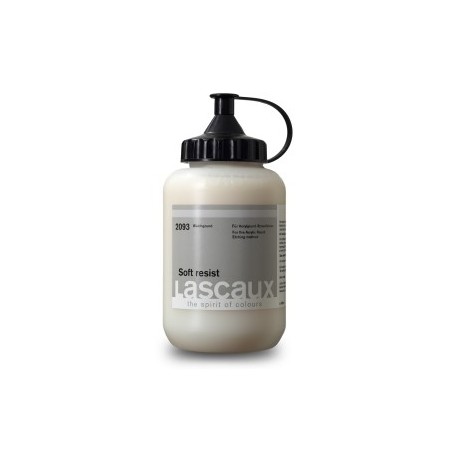REF

Lascaux
REF

Available in 85ml & 500ml bottles.
Lascaux Soft resist 2093 is water-soluble, ready to use, nontoxic and suitable for use on copper, brass, zinc, steel and aluminium. This slow drying resist is designed to offset easily, allowing a range of image-making methods to be explored. When the layer of resist is dry it may be drawn into with a range of etching tools or stopped-out. It is compatible with the other Lascaux resists and photopolymer.
Composition
Based on acrylic copolymer
This new-generation acid resist has been specially designed as part of the acrylic-resist etching system. The lines, marks and textures which can be generated by using this resist in its soft state are comparable to those offered by traditional soft grounds (soft drawn marks and collage textures).
Properties
Lascaux Soft resist is water-soluble, ready to use, nontoxic and suitable for use on copper, brass, zinc, steel and aluminium. This slow drying resist is designed to offset easily, allowing a range of image-making methods to be explored. When the layer of resist is dry it may be drawn into with a range of etching tools or stopped-out. It is compatible with the other Lascaux resists and photopolymer.
Directions
Plates should be prepared, grained, degreased and dried before the Soft resist is applied by brush (follow the detailed information provided in the technical sheet for Lascaux Hard resist).
Drawing and painting directly into the wet resist:
Apply the resist and within a few minutes draw directly on the plate with soft pencils, water-soluble chalks or crayons. This method can be used for around 15 minutes after application (longer in a cool studio). When the resist becomes too dry for this technique the crayon will catch and so drawing should cease to prevent the resist ripping. When the resist has dried thoroughly the graphite or crayon residues are washed away with warm water before working the plate further or etching. Characterful broad open (exposed metal) marks can be created by painting a little water onto the layer of clear resist as soon as it is applied. The diluted areas should be lifted away with a paint brush, cotton bud, cotton wool or soft tissue. The remaining resist is dried before the plate is worked further or etched.
Offset Drawing Method:
Drawings made with this classical method have a soft crayon-like appearance. Apply the resist, and after 10 or 15 minutes (depending on the speed of drying) place the plate face-up on the clean workboard, lay a sheet of tissue paper over the plate and cover this in turn with a sheet of textured drawing paper. Masking-tape the corners of the papers to the work board to prevent any slipping. Draw firmly on the drawing paper with a soft pencil or crayon. The pressure causes the resist to offset onto the absorbent tissue. When the image is complete remove the drawing paper and peel off the tissue paper. The image will be visible on the tissue paper but will be difficult to see on the plate.
The plate is dried and then flash bitten to darken the drawing. The plate may then be worked further or etched.
Offset collage method:
Images made with this classical method have a complex collage-like appearance. Apply the resist, and after 10 or 15 minutes (depending on the speed of drying) position the plate on a sheet of clean tissue on the etching press bed. Arrange a collage of low profile textured materials (such as feathers, leaves, threads and paper shapes) on the resist-covered plate. A sheet of thin transparent smooth PVC should be laid on top of the collage, followed by several clean sheets of tissue paper and the blankets of the etching press. The resist-coated plate, the collage and the PVC sheet are rolled through the etching press. The image will vary depending on how dry the resist is and on the pressure exerted by the press. After passing through the press the blankets, tissue and the top PVC sheet are lifted away. The collage will be embedded in the soft resist and an etching needle can be used to peel each item from the resist without creating unwanted marks. The resist is dried and the plate is flash bitten to darken the image. The plate then be worked further or etched.
Etching and resist removal Plates should etched following the detailed information provided in the technical sheet for Lascaux Hard resist. Dried resist can be removed with Lascaux Remover (follow the information provided in the technical sheet for Lascaux Hard resist or Lascaux Remover).
Working the plate further:
The surface may be lightly wet-sanded or polished to enhance the contrast and clarity before proofing. The plate may also be worked further using subtractive or additive methods.
More information
This product has been developed in collaboration with the printmakers Robert Adam and Carol Robertson who have been researching and teaching safer printmaking methods since 1990.
Specific References
You might also like